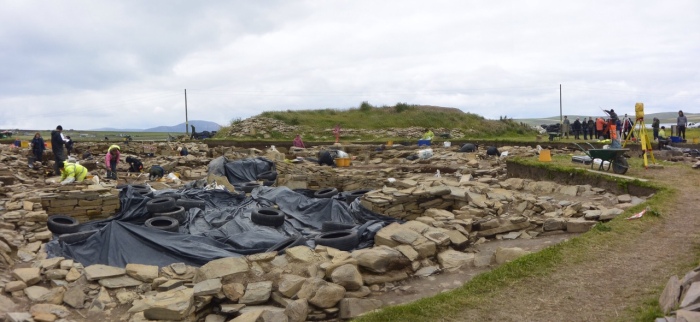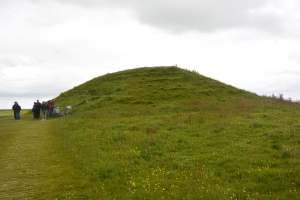Ness of Brodgar and the standing stones

Here’s something that wasn’t there on our last visit to Orkney! Well, it was, but it was buried under a farmer’s field. Ness of Brodgar is a thin finger of land between two lochs – to the south lie the Stones of Stenness and to the north the Ring of Brodgar (see below for more on both). The area is known as the Heart of Neolithic Orkney and has been a UNESCO World Heritage Site since 1999 (Skara Brae and Maes Howe are also nearby.) In 2003, a plough uncovered a large, worked stone and subsequent excavations revealed that the entire area of the Ness was covered with 5000 year old structures. We were lucky enough to visit the site on a day when an archaeologist was giving a tour and we spent 90 fascinating minutes having it explained to us and viewing some of the artefacts. The dig only takes place for a few weeks each year – if you are visiting Orkney in 2016, try to be there between 6th July and 24th August.
Ring of Brodgar
Ring of Brodgar is a 104m diameter circle with 27 of (possibly) 60 original stones still standing. It’s very dramatic.
Stones of Stenness
This is a smaller circle with four of its original 12 stones – the tallest is a slender 16 feet.
Nearby is Barnhouse, a Neolithic village which was occupied c 3200-2900 BC. What a beautiful place to live – I’d love that view, but only with 21st century living conditions!
Maes Howe

Maes Howe is one of Europe’s most impressive Neolithic burial chambers (3000 BC). There’s not much to see but a mound from the outside and photography is not allowed inside. You enter down a long, narrow passage which is aligned so that at the winter solstice the light of the setting sun shines straight down it and illuminates the back of the central chamber. Fortunately for my back, although it’s a small chamber, you can then stand upright. The tomb was discovered in 1861, but was more or less empty by then thanks to centuries of grave-robbing. Some intruders had left their marks – there’s a lot of Viking graffiti! Our guide said they used to call one section the postcard wall, but now she felt it was more like Twitter with its brief updates such as “Thor and I bedded Helga”.
Maes Howe operates on a timed-ticket system and you might have to book a couple of days in advance to get the slot you want, but it’s a must-see. It’s probably one of the two most famous sites on Orkney, the other being Skara Brae. I’ll tell you about it in my next post.


















![Top-20-Travel-Blogs-200×150[1]](https://i0.wp.com/www.holiday365.co.uk/blog/wp-content/uploads/2012/06/Top-20-Travel-Blogs-200x1501.png)
Amazing how some of these stones have withstood time (and weather!) 🙂
LikeLike
I know! Lost in admiration for ancient peoples and what they achieved. Our buildings would be long gone.
LikeLiked by 1 person
Fascinating Anabel – what amazing structures all these stones are! Love the modern interpretation of the Viking graffiti – it was probably like that! I would love the views too but also with 21st century living conditions – I should imagine it gets rather brisk in the winter to say the least! Wonderful photos thanks for sharing 🙂
LikeLike
It was rather brisk when we were there! Despite the blue skies in some pictures there was always a strong wind. Standing for an hour listening to the archaeologist I had a fleece, winter jacket and woolly hat and still felt cold. Living in stone houses …… brrrr!
LikeLiked by 1 person
I would have had to wear a snowsuit – always feel the cold when I come to the UK!!
LikeLiked by 1 person
I was not familiar with these very interesting sites. You’ve captured them beautifully! My favorite series is the Ring of Brodgar
LikeLike
They are all spectacular, I can’t decide on a favourite.
LikeLike